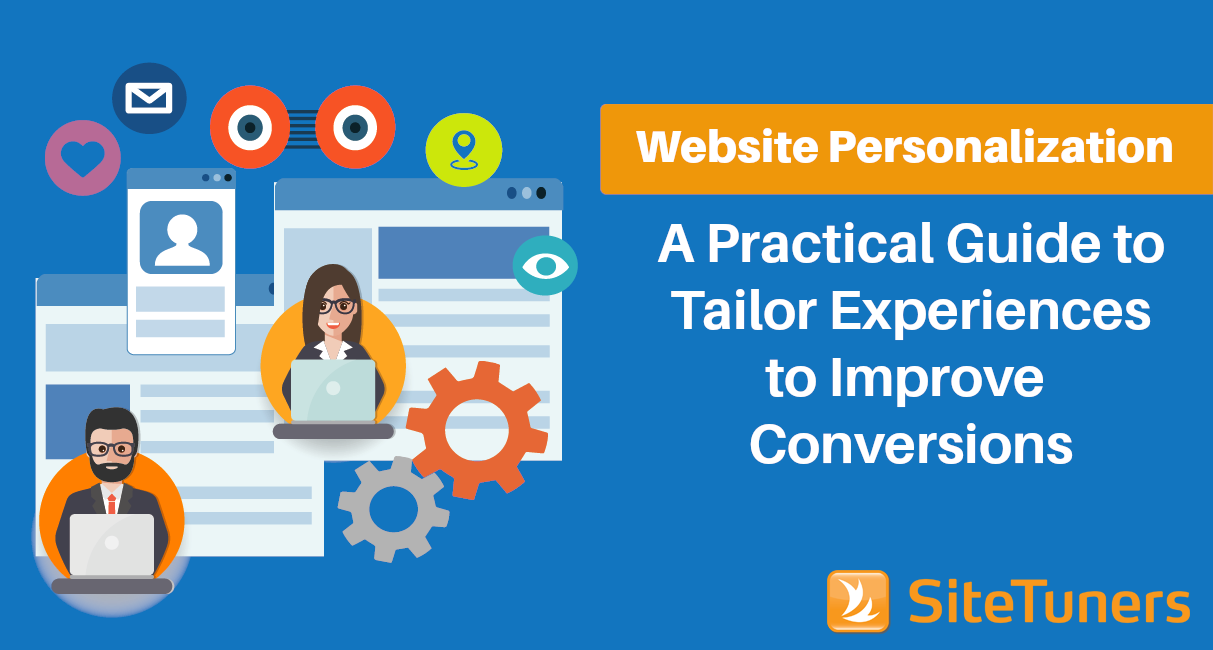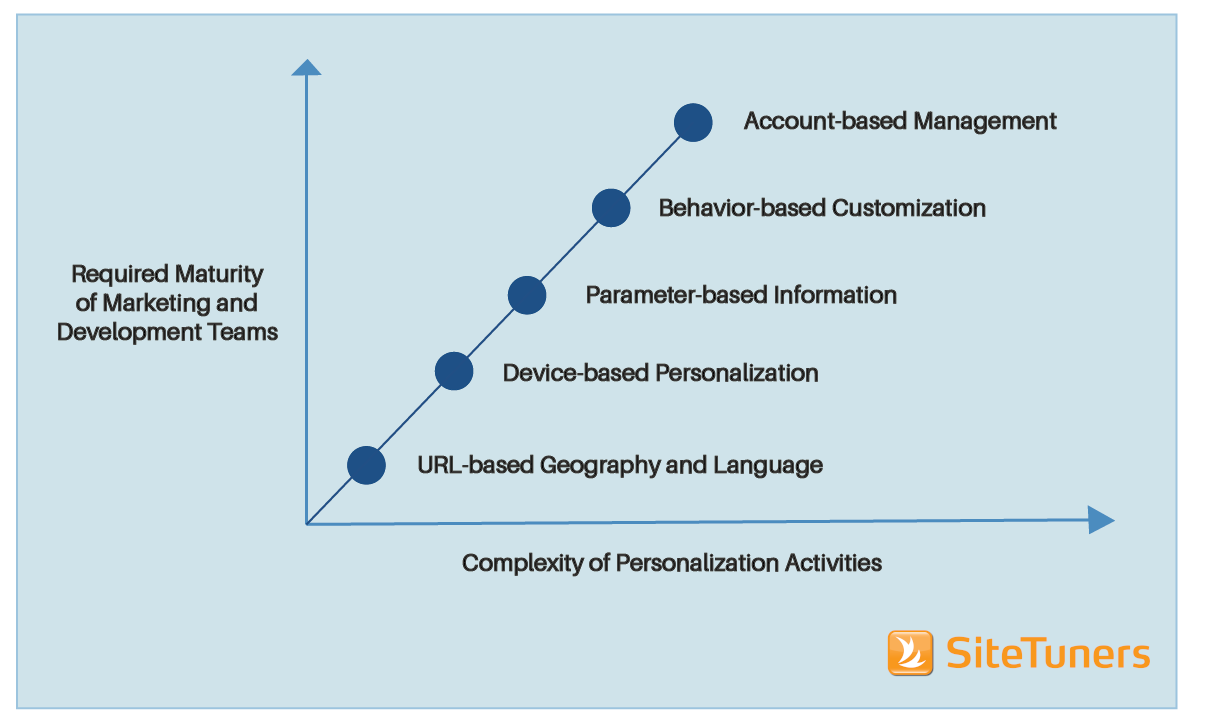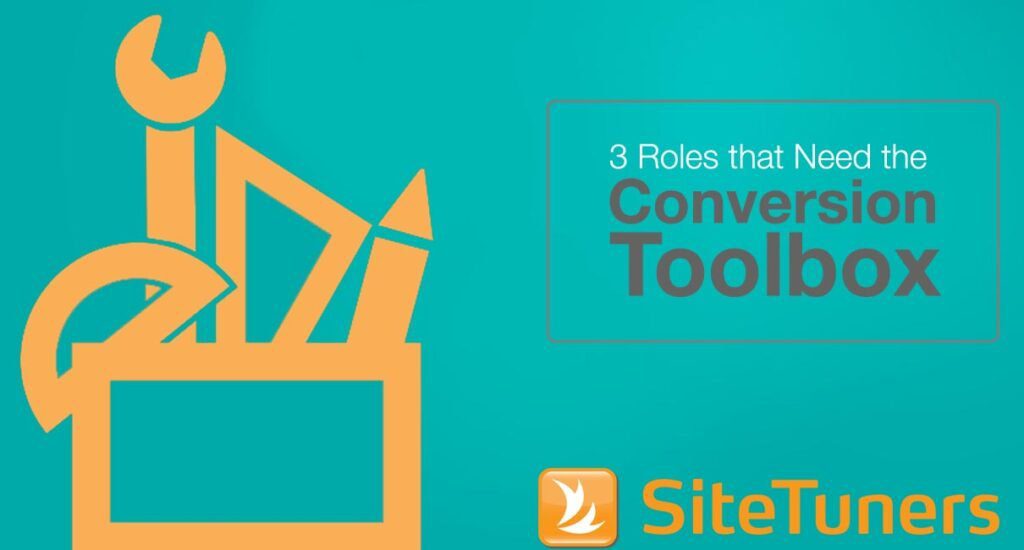At a very basic level, website personalization is relatively simple: your site will show tailored content to the different audience groups visiting your site. That is, different people will see different things. The idea is that things like custom buttons, promotions, and messaging will help you convert better.
When you examine personalization more closely, though, there’s a fair bit of complexity involved:
- Should you be personalizing based on ads?
- What about based on previous user behaviors on the site?
- What should you do with your URLs when you have different languages and locations?
- Can you harm your SEO efforts by personalizing content?
- Should you personalize based on marquee companies that tend to be more critical for your bottom line?
There are a ton of considerations. And while personalization is a great tool, not all types will be right for your needs. To find the personalization methods that will work for your marketing organization’s maturity and your visitors’ needs, you need to understand …
- the benefits,
- the techniques, and
- the complexity requirements of the personalization options on the table.
Let’s dive in.
What is Website Personalization?
Website personalization as a craft is more complex than different people seeing different things. It’s about your website “understanding” something about the visitor, and using that information to improve website user experience.
Different Forms of Website Personalization
In practice, website personalization can take many forms. If you …
- … know the location and language of a visitor, you can serve the right product set for their geography. And if you have the budget for translations, you can serve the content in the right language.
- … understand which ads drove them to your pages, you can tailor the downstream messaging to match things like the search phrases visitors used or ad content headlines that users clicked through.
- … identify what type of device the user has, you can omit or add content to make your page more effective.
- … know something about a visitor’s prior behavior like pages they viewed in the past, you can alter banners or parts of the current page they’re on to reflect that.
- … know which company the visitor is from, you can use custom messaging to cater to that company’s needs.
There are a lot of permutations that this can take. Maybe you’ll have data about the organization’s size, but not know the company name. Or maybe you’ll understand the e-mail referrer rather than the Google Ads search phrase.
That said, the fundamentals should remain roughly the same. Your system has some information about the visitor, and you’ll use that information to craft some personalization “rules” to try to make the website better.
What Are the Benefits of Website Personalization?
The level of complexity can vary depending on the type of personalization you want to achieve. It can be as simple as having a set of URLs to customize and manage every now and again. Or it can be as complex as having a team of professionals dealing with your account-based marketing software customizing messages.
You’ll need to find the right level of investment, one that matches your team’s goals as well as being within striking distance of your marketing organization’s resources and maturity.
Once you dip your toes in website personalization, though, you’ll see that there are many possibilities. That’s true even for small teams that can only deal with low-hanging fruit:
- Managing the titles of your ad group landing pages can help you match the messaging from the ad, and improve things like click-through rates.
- Changing calls-to-actions based on whether or not a person has visited before can be a boon for your landing page conversions.
- Delivering the right product set for a user’s country or region can help you avoid visitor frustration.
- Playing around with device-specific content like store locators for mobile devices and additional specifications for laptops and desktops can help raise your visitor task accomplishment rates.
- Getting the right content in front of specific companies can be a game changer for your inquiries and opportunities.
The benefits can be significant, but you’ll need to do your due diligence. Personalization is a harsh master for marketers who don’t do their homework.
Some things that look really simple can have hidden complexities. Meanwhile, other things that sound intimidating can be really simple to execute once you understand the moving parts.
Grow Your Business Exponentially with Proven Conversion Rate Optimization Expertise. |
What Are the Different Ways of Achieving Personalization?
To run a personalization task or project, you need a couple of things:
- Something you (or more accurately, your systems) understand about the user
- Some way to use that data to influence the website
The thing you understand about the user doesn’t always have to be sophisticated.
It can be as simple as your content management system (CMS) knowing that users from Germany should be served content under a certain path, like the /de/ in www.yourdomain.com/de/.
This can also be relatively complex. It can be a technical insertion from your account-based management tool telling you what’s known about the user’s IP address, and letting you tailor your content for certain organizations.
Information Sources
The thing that your systems understand will generally fall into 3 categories:
Information that users have volunteered
When visitors submit forms, they send you information that you can use to make their experience better the next time they visit your site. (Make sure you follow data privacy and consent rules. Learn about GDPR compliance.)
Information that your systems can pick up
Things like IP addresses, ads, and past behavior on your site can be used by your systems to customize the content.
Information augmented by third parties
Some services can read things like IP information and provide you company names or traits that you can then use to personalize content.
Changing the Experience Based on Data
The way you use the data to change the website experience can vary quite a bit. Here are a few typical scenarios:
Location strings on URL paths
This lets you retain the static content that is common across all geographies, but serve just the right product groups for the correct locations.
Parameters on URLs
This can create custom pre-selections for visitors, getting them closer to where they need to go.
Device information
This allows you to serve up pieces of content that only get served for mobile devices or desktops and laptops.
CMS personalization features
This runs the gamut from simple to complex features. It can be something uncomplicated like differentiating between new visitors and returning visitors and then serving different promoted content. Or it can be something more sophisticated like having rules around “remembering” previous pages, saved states, and serving the appropriate content.
Third party systems that work with your CMS
This can manage things like inserting pieces of content based on rules like which company the visitor is from.
You need to understand …
- the capabilities of your current CMS,
- the data points you have access to, and
- the technical capabilities within your team.
Then, you have to compare that to the type of personalization that will best fit the goals of your organization, and figure out if there are gaps that you need to close.
Are There Any Website Personalization Pitfalls to Watch Out For?
In 2021, there’s almost no excuse not to have at least some level of personalization running on your site. Not everyone needs expensive, sophisticated software for those personalization programs. But if you aren’t at least investigating the basics, you’re leaving money on the table.
If you’re new to this, there are a few things you should watch out for:
Maximize your CMS
Before you get a budget and put a request for proposal together for a personalization tool, make sure you understand the capabilities of your current CMS. There are likely some personalization features. You should kick the tires to see if those meet your current needs before you try to get other tools for the job.
Avoid parameters for location-based personalization, if possible
Try not to let your personalization efforts hurt your search engine rankings. If you need to manage your URLs for locations and languages, search engines like Google prefer that you do that via the domain or the URL path. The search engine spiders are not big fans of URL parameters for this purpose.
Start small and see where the gaps are
Crawl, then walk, then run. There are skills you’ll pick up while doing simpler personalization tasks that you’ll need when you’re running bigger projects.
Understand how you’ll measure success
Don’t personalize things just so you can tick a box on your task list. Understand what you’re trying to improve. And then, measure if your personalization efforts are moving the needle on things like click-through rates, conversions, task accomplishment rates, or form submissions.
Personalization is a field where planning and measurement are absolutely critical.
Finding the Right Website Personalization Solution in 2021
Some level of personalization is likely a must-have for most companies in 2021. With more companies turning to their digital footprint for revenues, it’s increasingly important to get this right. The reward can be a site that satisfies more visitors and converts better than the competition.
That said, it’s easy to fail to make the website better when personalizing content.
If you …
- start from a measurable goal,
- work with the data that you have,
- understand the capabilities of your current systems,
- plan carefully, and
- start small
… you’re more likely to have a personalization program that makes the website better.
Subscribe to the SiteTuners Weekly EmailGrow Your Business Exponentially with Proven Conversion Rate Optimization Expertise. |



